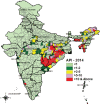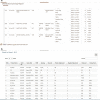A model for malaria elimination based on learnings from the Malaria Elimination Demonstration Project, Mandla district, Madhya Pradesh
- PMID: 33593368
- PMCID: PMC7888092
- DOI: 10.1186/s12936-021-03607-3
A model for malaria elimination based on learnings from the Malaria Elimination Demonstration Project, Mandla district, Madhya Pradesh
Abstract
Background: Malaria Elimination Demonstration Project (MEDP) was started as a Public-Private-Partnership between the Indian Council of Medical Research through National Institute of Research in Tribal Health, Govt. of Madhya Pradesh and Foundation of Disease Elimination and Control of India, which is a Corporate Social Responsibility (CSR) initiative of the Sun Pharmaceutical Industries Limited. The project's goal was to demonstrate that malaria can be eliminated from a high malaria endemic district along with prevention of re-establishment of malaria and to develop a model for malaria elimination using the lessons learned and knowledge acquired from the demonstration project.
Methods: The project employed tested protocols of robust surveillance, case management, vector control, and capacity building through continuous evaluation and training. The model was developed using the learnings from the operational plan, surveillance and case management, monitoring and feedback, entomological investigations and vector control, IEC and capacity building, supply chain management, mobile application (SOCH), and independent reviews of MEDP.
Results: The MEDP has been operational since April 2017 with field operations from August 2017, and has observed: (1) reduction in indigenous cases of malaria by about 91 %; (2) need for training and capacity building of field staff for diagnosis and treatment of malaria; (3) need for improvement insecticide spraying and for distribution and usage of bed-nets; (4) need for robust surveillance system that captures and documents information on febrile cases, RDT positive individuals, and treatments provided; (5) need for effective supervision of field staff based on advance tour plan; (6) accountability and controls from the highest level to field workers; and (7) need for context-specific IEC.
Conclusions: Malaria elimination is a high-priority public health goal of the Indian Government with a committed deadline of 2030. In order to achieve this goal, built-in systems of accountability, ownership, effective management, operational, technical, and financial controls will be crucial components for malaria elimination in India. This manuscript presents a model for malaria elimination with district as an operational unit, which may be considered for malaria elimination in India and other countries with similar geography, topography, climate, endemicity, health infrastructure, and socio-economic characteristics.
Keywords: Malaria elimination; Malaria model; Mandla; National malaria elimination.
Conflict of interest statement
The authors declare that they have no competing interests.
Figures







Similar articles
-
Malaria elimination: situation analysis of cases in India, the state of Madhya Pradesh in central India, and district Mandla of Madhya Pradesh.Front Public Health. 2024 Apr 9;12:1363736. doi: 10.3389/fpubh.2024.1363736. eCollection 2024. Front Public Health. 2024. PMID: 38655519 Free PMC article.
-
Study design and operational framework for a community-based Malaria Elimination Demonstration Project (MEDP) in 1233 villages of district Mandla, Madhya Pradesh.Malar J. 2020 Nov 16;19(1):410. doi: 10.1186/s12936-020-03458-4. Malar J. 2020. PMID: 33198754 Free PMC article.
-
Monitoring of the Village Malaria Workers to conduct activities of Malaria Elimination Demonstration Project in Mandla, Madhya Pradesh.Malar J. 2022 Jan 8;21(1):18. doi: 10.1186/s12936-021-04040-2. Malar J. 2022. PMID: 34998397 Free PMC article.
-
India could harness public-private partnerships to achieve malaria elimination.Lancet Reg Health Southeast Asia. 2022 Sep 12;5:100059. doi: 10.1016/j.lansea.2022.100059. eCollection 2022 Oct. Lancet Reg Health Southeast Asia. 2022. PMID: 37383669 Free PMC article. Review.
-
Fighting malaria in Madhya Pradesh (Central India): are we losing the battle?Malar J. 2009 May 7;8:93. doi: 10.1186/1475-2875-8-93. Malar J. 2009. PMID: 19419588 Free PMC article. Review.
Cited by
-
Global dengue fever management in health systems: identifying strategies, challenges and solutions - a scoping review protocol.BMJ Open. 2025 Apr 25;15(4):e097085. doi: 10.1136/bmjopen-2024-097085. BMJ Open. 2025. PMID: 40280619 Free PMC article.
-
Impact of the malaria comprehensive case management programme in Odisha, India.PLoS One. 2022 Mar 24;17(3):e0265352. doi: 10.1371/journal.pone.0265352. eCollection 2022. PLoS One. 2022. PMID: 35324920 Free PMC article.
-
Evaluation of the model malaria elimination strategy in Mandla district along with its neighbouring districts: a time series analysis from 2008 to 2020.Malar J. 2023 Feb 6;22(1):45. doi: 10.1186/s12936-023-04477-7. Malar J. 2023. PMID: 36747302 Free PMC article.
-
Implementation and acceptance of government-sponsored malaria control interventions in Meghalaya, India.Malar J. 2022 Jun 23;21(1):200. doi: 10.1186/s12936-022-04223-5. Malar J. 2022. PMID: 35739533 Free PMC article.
-
A constant contact community-based epidemiological investigation (C3EI) as part of malaria elimination demonstration project, Mandla district, Madhya Pradesh, India.Malar J. 2024 Oct 25;23(1):321. doi: 10.1186/s12936-024-05143-2. Malar J. 2024. PMID: 39456035 Free PMC article.
References
-
- WHO. World Malaria Report 2020. Geneva, World Health Organization, 2020.
-
- Ministry of Health and Family Welfare . National Framework for Elimination of Malaria in India 2016-30. India: NVBDCP. Delhi; 2017.
-
- National Vector Borne Disease Control Programme . Strategic Plan for Malaria Control in India 2012–2017. India: Delhi; 2012.
-
- Rajvanshi H, Bharti PK, Nisar S, Jain Y, Jayswar H, Mishra AK, et al. Study design and operational framework for a community-based Malaria Elimination Demonstration Project (MEDP) in 1233 villages of district Mandla, Madhya Pradesh. Malar J. 2020;19:410. doi: 10.1186/s12936-020-03458-4. - DOI - PMC - PubMed
MeSH terms
LinkOut - more resources
Full Text Sources
Other Literature Sources
Medical
Miscellaneous

